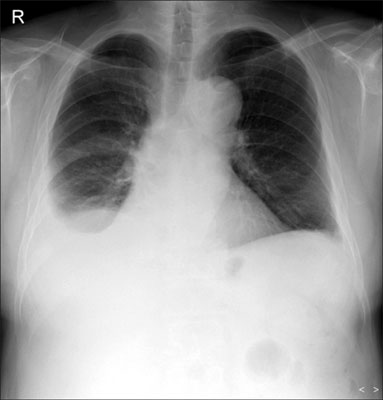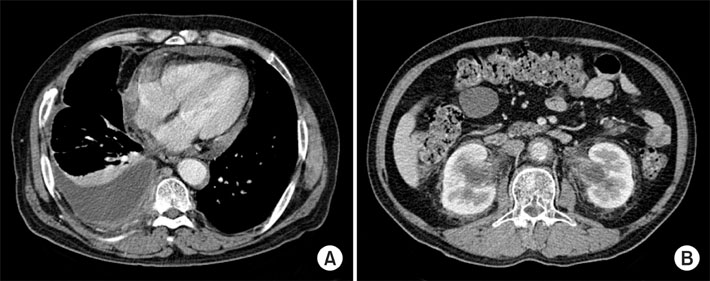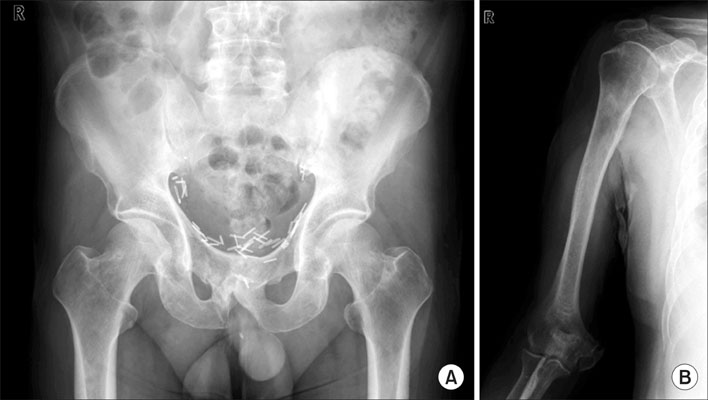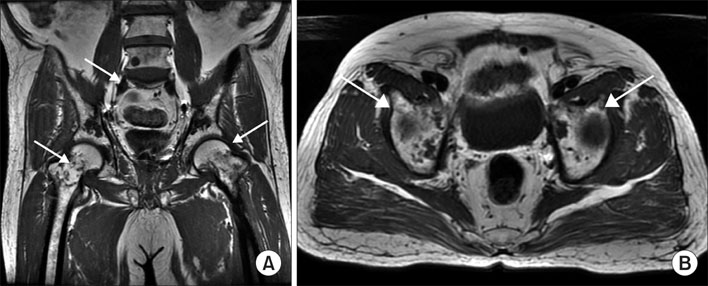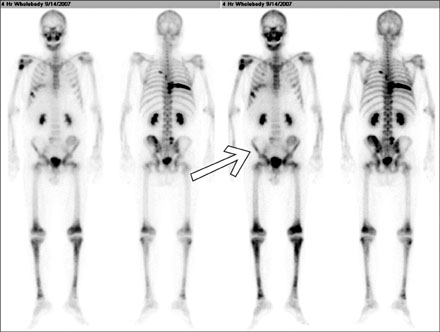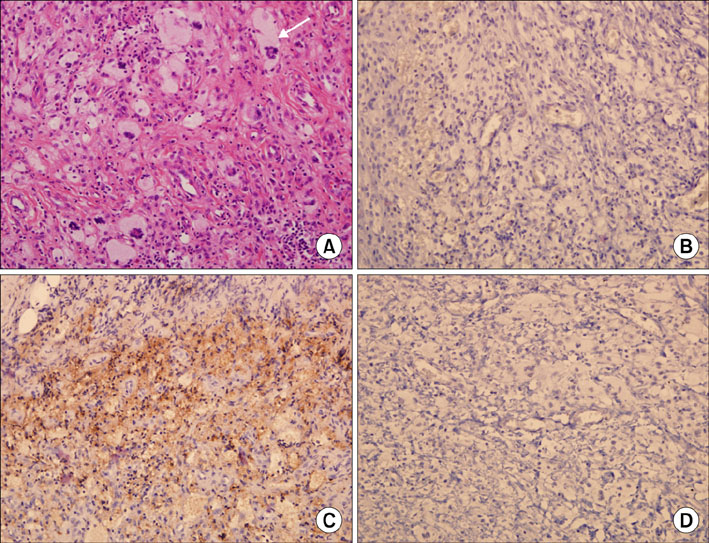Tuberc Respir Dis.
2008 Mar;64(3):224-229. 10.4046/trd.2008.64.3.224.
A Case of Erdheim-Chester Disease Who Has Policythemia Vera
- Affiliations
-
- 1Division of Pulmonary Medicine, St. Mary's Hospital, Department of Internal Medicine, The Catholic University of Korea College of Medicine, Seoul, Korea. jssong@catholic.ac.kr
- KMID: 1478186
- DOI: http://doi.org/10.4046/trd.2008.64.3.224
Abstract
- Erdheim-Chester disease (ECD) is a rare disease that is characterized by multi-organ involvement of foamy histiocytes. It causes systemic inflammation, and also demonstrates various clinical manifestations and has a poor prognosis. We encountered a case of ECD in a patient that had been treated for underlying polycythemia vera. As far as we know, this is the first reported case worldwide where ECD developed in association with polycythemia vera. A 59-year-old man visited our hospital due to pleuric pain at the right side of the chest. Pleural tissue that was obtained following a thoracoscopic biopsy showed non-Langerhan's cell histiocytosis, suggesting the presence of ECD. The histiocytes stained positively for CD68, but were negative for S-100 and CD1a. The patient also complained of pain at both hips and the right shoulder area. An X-ray and magnetic resonance image demonstrated that the lesion showed sclerosis and osteolysis in both the proximal femur and right humerus. Treatment was started with predinisolone, and subsequently cyclophosphamide was added. ECD is a very rare multi-systemic disease, and its cause and therapeutic options have not yet been defined. ECD has a poor prognosis. Therefore, we believe that additional case studies are needed prior to the determination of a novel therapy for ECD.
MeSH Terms
Figure
Reference
-
1. Devouassoux G, Lantuejoul S, Chatelain P, Brambilla E, Brambilla C. Erdheim-Chester disease: a primary macrophage cell disorder. Am J Respir Crit Care Med. 1998. 157:650–653.2. Allen TC, Chevez-Barrios P, Shetlar DJ, Cagle PT. Pulmonary and ophthalmic involvement with Erdheim-Chester disease: a case report and review of the literature. Arch Pathol Lab Med. 2004. 128:1428–1431.3. Hwang HS, Ji BS, Lee CK, Kim JY, Choi BS, Yang CW, et al. A case of Erdheim-Chester disease that presented with chronic renal failure. Korean J Med. 2007. 73:216–222.4. Kim YJ, Kim YD. Erdheim-Chester disease: two cases of orbital involvement. J Korean Ophthalmol Soc. 2002. 43:1323–1329.5. Park YK, Ryu KN, Huh B, Kim JD. Erdheim-Chester disease. J Korean Med Sci. 1999. 14:323–326.6. Hong JR, Lee HG, Ko YH, Ahn JM, Choi YH, Kim BT. A case of Erdheim-Chester disease with periodic fever and knee pain. Korean J Med. 1999. 56:542–546.7. Veyssier-Belot C, Cacoub P, Caparros-Lefebvre D, Wechsler J, Brun B, Remy M, et al. Erdheim-Chester disease. Clinical and radiologic characteristics of 59 cases. Medicine (Baltimore). 1996. 75:157–169.8. Sheu SY, Wenzel RR, Kersting C, Merten R, Otterbach F, Schmid KW. Erdheim-Chester disease: case report with multisystemic manifestations including testis, thyroid, and lymph nodes, and a review of literature. J Clin Pathol. 2004. 57:1225–1228.9. Favara BE, Jaffe R. Pathology of Langerhans cell histiocytosis. Hematol Oncol Clin North Am. 1987. 1:75–95.10. Chung JH, Park MS, Shin DH, Choe KO, Kim SK, Chang J, et al. Pulmonary involvement in Erdheim-Chester disease. Respirology. 2005. 10:389–392.11. Athanasou NA, Barbatis C. Erdheim-chester disease with epiphyseal and systemic disease. J Clin Pathol. 1993. 46:481–482.12. Koziolek MJ, Kunze E, Muller A, Thiem V, Scheel AK, Muller D, et al. Erdheim-Chester disease. Dtsch Med Wochenschr. 2005. 130:25–28.13. Bourke SC, Nicholson AG, Gibson GJ. Erdheim-Chester disease: pulmonary infiltration responding to cyclophosphamide and prednisolone. Thorax. 2003. 58:1004–1005.14. Boissel N, Wechsler B, Leblond V. Treatment of refractory Erdheim-Chester disease with double autologous hematopoietic stem-cell transplantation. Ann Intern Med. 2001. 135:844–845.15. Braiteh F, Boxrud C, Esmaeli B, Kurzrock R. Successful treatment of Erdheim-Chester disease, a non-Langerhans-cell histiocytosis, with interferon-alpha. Blood. 2005. 106:2992–2994.
- Full Text Links
- Actions
-
Cited
- CITED
-
- Close
- Share
- Similar articles
-
- Erdheim-Chester Disease with Perirenal Masses Containing Macroscopic Fat Tissue
- Commentary on "A Case of Erdheim-Chester Disease with Asymptomatic Renal Involvement"
- Reply to Commentary on "A Case of Erdheim-Chester Disease with Asymptomatic Renal Involvement"
- A Case of Erdheim-Chester Disease with Bilateral Hydronephrosis
- Erdheim–Chester Disease Involving the Biliary System and Mimicking Immunoglobulin G4-Related Disease: A Case Report

